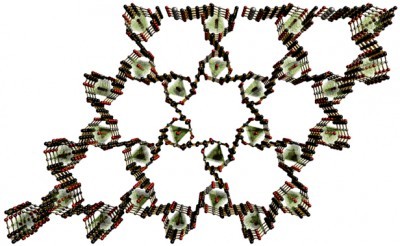Nanosponge filters out herbicide poisons from water
A team of researchers, led by Dr Mainak Majumder and Phillip Sheath from Monash University’s Department of Mechanical Engineering and Dr Matthew Hill from CSIRO Materials Science and Engineering, have developed a highly porous metal-organic framework (MOF) that, almost uniquely, is stable and able to filter substances in water.
MOFs are clusters of metal atoms connected by organic molecules and known for their exceptional abilities to store or separate gases such as carbon dioxide. In fact, in 2012 Dr Hill developed MOFs that were capable of 300% more CO2 storage than currently used materials.

The current study is one of the first to demonstrate the separation applications of MOFs in an aqueous environment, yet one which was perhaps inevitable given that, as Dr Majumder explains, the uniform structure of MOFs makes them very efficient filters.
“These are crystalline materials with a difference - they have pores that are all exactly the same size. So while one substance can fit in the pores and be captured, another, just one tenth of a nanometre bigger, can’t fit,” Dr Majumder said.
“As a result you can detect and capture substances that are present in low concentrations, or in a mixture with other materials.”
The researchers developed their own isostructural MOF based on the perylene tetracarboxylate (PTC) ligand, resulting in a highly porous topology and resistance to moisture. It also exhibited a flexibility that leads to strong and selective gas adsorption characteristics.
The MOF’s filtering ability was demonstrated through the aqueous molecular sieving of paraquat, a herbicide that has been linked with the onset of Parkinson’s disease. The MOF removed the paraquat but left other contaminants behind.
“Because MOFs are flexible, we found that their structure changed when they absorbed the paraquat,” said Dr Hill.
“This means that our MOF could form the basis of a device for quickly and easily testing for the contaminant in water.
“Due to its very precise filtering properties, this testing application could deliver very accurate contamination readings in the field.”
Paraquat was the only contaminant tested in the study; however, the MOF could be altered to filter out other contaminants.
The research was published in the journal Chemistry of Materials.
$14K community grant provides water savings for school
Lalor North Primary School has undergone a water-saving transformation thanks to a community...
Lagoon cover dewatering solution for Gippsland Water
Gippsland Water was experiencing issues with its cover dewatering pumps, which were solved...
The role of AI in smart water management
IoT sensors, AI and predictive analytics are emerging as key solutions to enhance water...










